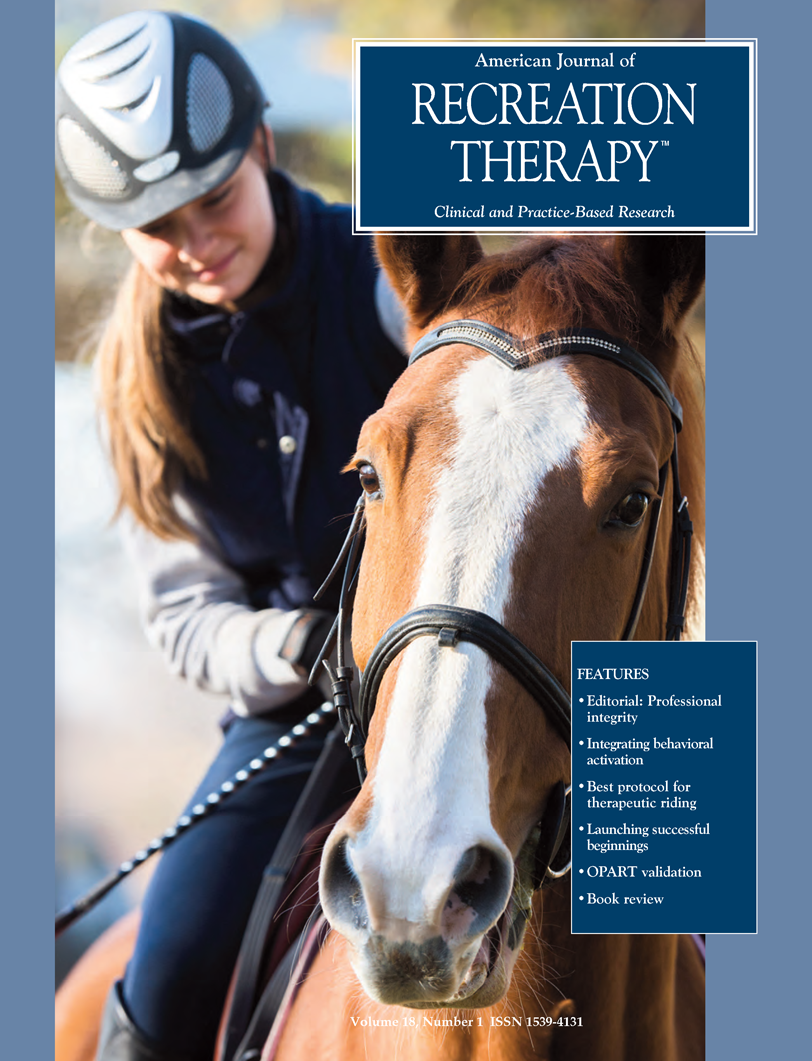Identifying the best protocol: Social engagement or groundwork prior to therapeutic riding?
DOI:
https://doi.org/10.5055/ajrt.2019.0178Keywords:
therapeutic riding, social skills, groundwork, autism spectrum disorder, adolescentsAbstract
Adolescents with autism spectrum disorder may experience social isolation and decreased independence secondary to communication deficits. Limited evidence suggests therapeutic riding (TR) promotes social skills, but no protocol for TR with adolescents exists. This 8-week single-subject design measured social response to alternating treatments (groundwork or peer social engagement) prior to TR. Measures included a comparison of parent-report of social competence and a comparison of real-time and videotaped observations of six specific social skills. Data were analyzed by visual inspection of the graphed data and comparison of the descriptive statistics. Peer interaction prior to TR resulted in better verbal response while groundwork prior to TR resulted in better instruction following. In a departure from common practice of combining groundwork and TR, the specific goals and objectives for the individual with ASD should dictate whether a CTRS® should use social games or groundwork prior to TR.
References
Baio J, Wiggins L, Christensen DL, et al.: Prevalence of autism spectrum disorder among children aged 8 years—Autism and developmental disabilities monitoring network, 11 sites, United States, 2014. MMWR Surveill Summ. 2018; 67(6): 1-23. doi:10.15585/mmwr.ss6706a1.
Voelkmar F, Wolfe J: When children with autism become adults. World Psychiatry. 2013; 12(1): 79-80.
American Psychiatric Association: Diagnostic and Statistical Manual of Mental Disorders: DSM-5. Arlington, VA: American Psychiatric Publishing, 2013.
Lipscomb S, Haimson J, Liu AY, et al.: Preparing for life After High School: The Characteristics and Experiences of Youth in Special Education. Findings from the National Longitudinal Transition Study 2012. Vol 2: Comparisons Across Disability Groups: Executive Summary. Washington, DC: US Department of Education, 2017. NCEE 2017–4019. Available at https://ies.ed.gov/ncee/projects/evaluation/disabilities_nlts2012.asp.
US Department of Health and Human Services: Report to Congress: Young adults and transitioning youth with autism spectrum disorder. 2017. Available at https://www.hhs.gov/sites/default/files/2017AutismReport.pdf. Accessed July 17, 2018.
Church C, Alisanski S, Amanullah S: The social, behavioral, and academic experiences of children with Asperger’s syndrome. Focus Autism Dev Dis. 2000; 15: 12-20.
Jung S, Sainato DM: Teaching games to young children with autism spectrum disorder using specialized interests and video modeling. J Intellect Dev Disabil. 2015; 49(2): 198-212. doi:10.3109/13668250.2015.1027674.
Reichow B, Volkmar FR: Social skills interventions for individuals with autism: Evaluation for evidence-based practices within a best evidence synthesis framework. J Autism Dev Disord. 2010; 40: 149-166. doi:10.1007/s10803-009-0842-0.
Koegel LK, Vernon TY, Koegel RL, et al.: Improving social engagement and initiations between children with autism spectrum disorder and their peers in inclusive settings. J Posit Behav Interv. 2012; 14(4): 220-227. doi:10.1177/1098300712437042.
Holm MB, Baird JM, Kim YJ, et al.: Therapeutic horseback riding outcomes of parent-identified goals for children with autism spectrum disorder. J Autism Dev Disord. 2014; 44: 937-947.
Harris A, Williams JM: The impact of a horse riding intervention on youth with autism spectrum disorder. Int J Environ Res Public Health. 2017; 14: 17.
Hawkins BL, Ryan JB, Cory AL, et al.: Effects of equine-assisted therapy on gross motor skills of two children with autism spectrum disorder: A single-subject research study. Ther Recreation J. 2014; 48(2): 135-149.
Ajzenman H, Standeven J, Shurtleff T: The effect of hippo-therapy on motor control, adaptive behaviors, and participation in children with autism spectrum disorders a pilot study. Am J Occup Ther. 2013; 67(6): 653-663. doi:10.5014/ajot.2013.008383.
Borgi M, Cirulli F: Pet face: Mechanisms underlying human-animal relationship. Front Psychol. 2016; 7: 298.
O’Haire ME: Animal-assisted intervention for autism spectrum disorder: A systematic literature review. J Autism Dev Disord. 2012; 43: 1606-1622.
Gast D: Single-Subject Research Methodology in Behavioral Sciences. New York, NY: Routledge, 2010.
Wolery M, Dunlap G, Ledford JR: Single-case experimental methods: Suggestions for reporting. J Early Interv. 2011; 33: 103-109.
Haegle JA, Hodge SR: The applied behavior analysis research paradigm and single-subject designs in adapted physical activity research. Adapt Phys Activ Q. 2015; 32: 285-301.
Siedler A: Beyond social skills: Group dynamics at social skills training for high functioning adolescents with autism spectrum disorders. Probl Psychol 21st Century. 2015; 9(1): 20-25.
Hayes SC, Blackledge JT: Single-case experimental designs. In Bellack AS, Hersen M (eds.): Comprehensive Clinical Psychology. Edinburgh: Elsevier Science, 1998: 23-45.
Peters BC, Wood W: Autism and equine-assisted interventions: A systematic mapping review. J Autism Dev Disord. 2017; 47: 3220-3242.
Sackett DL, Rosenberg WM, Gray JA, et al.: Evidence based medicine: What it is and what it isn’t. BMJ. 1996; 312(7023): 71-72.
Published
How to Cite
Issue
Section
License
Copyright 2000-2023, Weston Medical Publishing, LLC
All Rights Reserved


